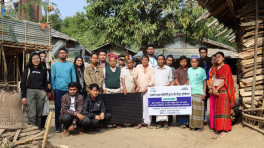Researchers achieve milestone on path toward nuclear fusion energy
The experiments produced the self-heating of matter in a plasma state through nuclear fusion

US government scientists said on Wednesday they have taken an important step in the long trek toward making nuclear fusion - the very process that powers stars - a viable energy source for humankind.
Using the world's largest laser, the researchers coaxed fusion fuel for the first time to heat itself beyond the heat they zapped into it, achieving a phenomenon called a burning plasma that marked a stride toward self-sustaining fusion energy.
The energy produced was modest - about the equivalent of nine nine-volt batteries of the kind that power smoke detectors and other small devices. But the experiments at a Lawrence Livermore National Laboratory facility in California represented a milestone in the decades-long quest to harness fusion energy, even as the researchers cautioned that years of more work are needed.
The experiments produced the self-heating of matter in a plasma state through nuclear fusion, which is the combining of atomic nuclei to release energy. Plasma is one of the various states of matter, alongside solid, liquid and gas.


 Keep updated, follow The Business Standard's Google news channel
Keep updated, follow The Business Standard's Google news channel
















